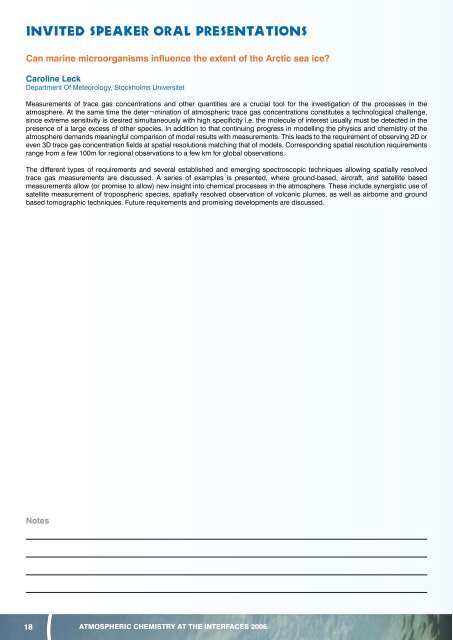Download Programme Here - IGAC Project
Download Programme Here - IGAC Project
Download Programme Here - IGAC Project
Create successful ePaper yourself
Turn your PDF publications into a flip-book with our unique Google optimized e-Paper software.
INVITED SPEAKER ORAL PRESENTATIONS<br />
Can marine microorganisms influence the extent of the Arctic sea ice?<br />
Caroline Leck<br />
Department Of Meteorology, Stockholms Universitet<br />
Measurements of trace gas concentrations and other quantities are a crucial tool for the investigation of the processes in the<br />
atmosphere. At the same time the deter¬mination of atmospheric trace gas concentrations constitutes a technological challenge,<br />
since extreme sensitivity is desired simultaneously with high specificity i.e. the molecule of interest usually must be detected in the<br />
presence of a large excess of other species. In addition to that continuing progress in modelling the physics and chemistry of the<br />
atmosphere demands meaningful comparison of model results with measurements. This leads to the requirement of observing 2D or<br />
even 3D trace gas concentration fields at spatial resolutions matching that of models. Corresponding spatial resolution requirements<br />
range from a few 100m for regional observations to a few km for global observations.<br />
The different types of requirements and several established and emerging spectroscopic techniques allowing spatially resolved<br />
trace gas measurements are discussed. A series of examples is presented, where ground-based, aircraft, and satellite based<br />
measurements allow (or promise to allow) new insight into chemical processes in the atmosphere. These include synergistic use of<br />
satellite measurement of tropospheric species, spatially resolved observation of volcanic plumes, as well as airborne and ground<br />
based tomographic techniques. Future requirements and promising developments are discussed.<br />
Notes<br />
POSTER PRESENTATIONS: sESSION 1<br />
Atmospheric chemistry observations and their intergration and synthesis<br />
S1P1 Action plan to air pollution in Matanzas.<br />
Barbaro V Moya, Citma<br />
S1P2 The Contribution of Volcanic Plumes to Urban Air Pollution<br />
Kim Natasha Dirks, The University Of Auckland<br />
Margaret L. Peace, Geoff L. Austin, Alessandro Nanni<br />
S1P3 Laboratory and modeling studies of aqueous phase reactions of OH radicals with organic compounds of<br />
relevance for atmospheric chemistry<br />
Paolo Barzaghi, Leibniz-Institut Für Troposphärenforschung<br />
Andreas Tilgner, Barbara Weigert, Hartmut Herrmann<br />
S1P4 Theoretical Determination of Thermodynamic Properties for Gas-Phase and Aqueous-Phase Reactions of<br />
Atmospheric Sulphur<br />
Anselm Igbafe, University Of The Witwatersrand<br />
Linda Jewell, Stuart Piketh<br />
S1P5 The GEIA/ACCENT database of emissions<br />
Alex Guenther, National Center for Atmospheric Research, Boulder, USA<br />
Claire Granier, Aude Mieville, Paulette Middleton<br />
S1P6 ECCAD: a GEIA-ACCENT database of driving variables<br />
Christelle Michel, Service D’Aéronomie/IPSL<br />
Claire Granier, Cathy Boonne, Francoise Girod, Thierry Phulpin<br />
S1P7 The CARIBIC Airbus 340-600 as a powerful Global Atmosphere Watch system<br />
Franz Slemr, Max-Planck-Institute For Chemistry<br />
CARIBIC team<br />
S1P8 The PREV’AIR system for operational air quality monitoring and forecasting over Europe<br />
Frederik Meleux, Ineris<br />
Cécile Honor, Bertrand Bessagnet, Laurence Rouil, Robert Vautard, Nathalie Poisson, Vincent-Henri Puech<br />
S1P9 ACCENT: Highlights from the European Network of Excellence on Atmospheric Composition Change<br />
Michela Maione, University of Urbino<br />
Sandro Fuzzi, ACCENT Consortium<br />
S1P10 On use of the chemical composition and climate web-archives for scientific purposes<br />
Natalia Andronova, Univesity Of Michigan, AOSS<br />
S1P11 Evaluation of sources and sinks of atmospheric CO2 and CH4 in the Mediterranean through backward<br />
airmass trajectory analysis<br />
Florinda Artuso, Enea Clim-Oss<br />
Alcide di Sarra, Paolo Chamard, Daniela Meloni, Francesco Monteleone, Salvatore Piacentino<br />
S1P12 EUSAAR (European Supersites for Atmospheric Aerosol Research)<br />
Paolo Laj, Laboratoire De Météorologie Physique - CNRS - Unversity Of Clermont-Ferrand<br />
S1P13 Atmospheric Composition Change: Training and Education in a Network of Excellence<br />
Evi Schuepbach, Cabo3 / Physical Geography / University Of Berne<br />
S1P14 Integration and Synthesis of Observations: The Annual Greenhouse Gas Index, Ozone Depleting Gas<br />
Index and GLOBALVIEW Cooperative Data Integration <strong>Project</strong><br />
David J. Hofmann, NOAA Earth System Research Laboratory<br />
Leonard A. Barrie, James H. Butler, Edward Dlugokencky, James W. Elkins, Kenneth Masarie, Stephen A. Montzka, Pieter P.<br />
Tans<br />
S1P15 Observational Study of í°BBCí ± - Beijing Brown Clouds<br />
Guang-Yu Shi, State Key Laboratory of Numerical Modeling for Atmospheric Sciences and Geophysics<br />
Bin Chen, Yasunobu Iwasaka, Masahiko Hayashi<br />
S1P16 Potential Future ESA Atmospheric Chemistry Missions for Research and Operational Applications<br />
Joerg Langen, Esa-Estec<br />
S1P17 Uncertainties in Measuring Aerosol Absorption: Advances to the Measurements using Photoacoustic<br />
Spectroscopy<br />
Daniel Lack, National Oceanic And Atmospheric Administration / University Of Colorado - CIRES<br />
Edward Lovejoy, Tahlee Baynard, Anders Pettersson, A.R. Ravishankara<br />
S1P18 Physical and optical properties of aerosols over an urban location in western India: Seasonal variability<br />
and implications for shortwave radiative forcing<br />
Dilip Ganguly, Physical Research Laboratory<br />
A Jayaraman<br />
1 ATMOSPHERIC CHEMISTRY AT THE INTERFACES 2006 1<br />
ATMOSPHERIC CHEMISTRY AT THE INTERFACES 2006








